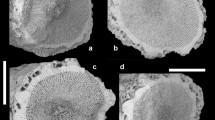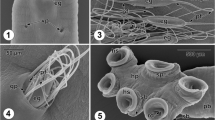Abstract
The ultrastructure of primary spines (microscopic relief of the surface of radial wedges on the spines and cross-sections of the spines) was studied by scanning electron microscopy in seven sea urchin species of the family Strongylocentrotidae. The spines were taken from the ambitus area of equally sizes individuals with a test diameter of 50 ± 5 mm. According to the number of wedges on their spines, the studied species can be divided into three groups: Strongylocentrotus intermedius, S. pallidus (18–25 wedges), S. droebachiensis, S. polyacanthus, Allocentrotus fragilis (24–32), and Mesocentrotus franciscantus, S. nudus (45–70). The species visibly differ in the microrelief of the wedges, which can be longitudinally streaked, with protuberances, with cross-dentate or non-dentate wedges, or with cross-series of denticles; in some species, the relief is absent. In S. intermedius, spines with smooth surface of the wedges, longitudinally streaked, with sparse protuberances, and with numerous cross-series of denticles only distally, only proximally, or over the entire length of the spine have been found. Wedge surface is convex or flattened in cross-sections; wedge shape in cross-section is rectangular (S. droebachiensis, S. intermedius, S. polyacanthus), triangular (S. pallidus), trapezoid (S. fragilis), or ansiform (M. franciscanus, M. nudus). Species of the genus Mesocentrotus are readily distinguished from the other species by the stereome of their spines: wider than the height of the wedges and more homogeneous, without regular concentric circles. Data on the ultrastructure of primary spines confirm the generic status of Mesocentrotus Tatarenko et Poltaraus, 1993 and do not support the recognition of Allocentrotus Mortensen, 1942 as a distinct genus.
Similar content being viewed by others
References
Agassiz, A. and Clark, H.L., Preliminary Report on the Echini Collected in 1906 by the U.S. Fish Commission Steamer Albatross, Bull. Mus. Comp. Zool. Harvard, 1907, vol. 51, pp. 109–139.
Baranova, Z.I., Echinoderms in the Bering Sea, in Issledovaniya dal’nevostochnykh morei SSSR (Studies in the Far Eastern Seas of the Soviet Union), Leningrad: Akad. Nauk SSSR, 1957, vol. 4, pp. 149–266.
Bazhin, A.G., Species Composition, Living Conditions, and Distribution of Strongylocentrotus Sea Urchins in Russian Seas, Extended Abstract of Cand. Sci. (Biol.) Dissertation, Vladivostok, 1995.
Bazhin, A.G. and Stepanov, V.G., Morphological Variation in Some Sea Urchin Species of the Genus Strongylocentrotus Depending on Environmental Factors, Zool. Zh., 2002, vol. 81, no. 12, pp. 1487–1493.
Biermann, C., Kessing, B., and Palumbi, S., Phylogeny and Development of Marine Model Species: Strongylocentrotid Sea Urchins, Evol. Dev., 2003, vol. 5, pp. 360–371.
Clark, H.L., Hawaiian and Other Pacific Echini, Mem. Mus. Comp. Zool. Harvard, 1912, vol. 34, pp. 338–364.
Drozdov, A.L. and Vinnikova, V.V., Morphology of Gametes in Sea Urchins from Peter the Great Bay, Sea of Japan, Russ. J. Dev. Biol., 2010, vol. 41, no. 1, pp. 37–45.
Dubois, Ph. and Ameye, L., Regeneration of Spines and Pedicellariae in Echinoderms: A Review, Microsc. Res. Techn,, 2001, vol. 55, pp. 427–437.
D’yakonov, A.M., Iglokozhie severnykh morei (Echinoderms in the Northern Seas), Opredeliteli po faune SSSR (Identification Keys to the Fauna of the Soviet Union), vol. 8, Leningrad: Zool. Inst. Akad. Nauk SSSR, 1933.
Ebert, T., A New Theory to Explain the Origin of Growth Lines in Sea Urchin Spines, Mar. Ecol.: Proc. Ser., 1986, vol. 34, pp. 197–199.
Jackson, R.T., Phylogeny of the Echini, with a Revision of Paleozoic Species, Mem. Boston Soc. Nat. Hist., 1912, no. 7, pp. 1–491.
Jensen, M., The Strongylocentrotidae (Echinoidea): A Morphologic and Systematic Study, Sarsia, 1974, vol. 57, pp. 113–148.
Kryuchkova, G.A. and Solov’ev, A.N., On the Larval Stage of Sea Urchins, Paleontol. Zh., 1975, no. 4, pp. 63–71.
Mortensen, Th., A Monograph of the Echinoidea, vol. 3: Camarodonta: 2. Echinidae, Strongylocentrotidae, Parasaleniidae, Echinometridae, Copenhagen: C.A. Reitzel, 1943.
Strathmann, R.R., Echinoid Larvae from the Northeast Pacific (with a Key and Comment on an Unusual Type of Planktotrophic Development), Can. J. Zool., 1979, vol. 57, pp. 610–616.
Su, X., Kamat, S., and Heuer, A.H., The Structure of Sea Urchin Spines, Large Biogenic Single Crystals of Calcite, J. Mater. Sci., 2000, vol. 35, no. 22, pp. 5545–5551.
Tatarenko, D.E. and Poltaraus, A.B., Attribution of the Sea Urchin Pseudocentrotus depressus to the Family Strongylocentrotidae and Separation within This Group of the New Genus Mesocentrotus Based on Data of DNA-DNA hybridization and Comparative Morphology, Zool. Zh., 1993, vol. 72, no. 2, pp. 61–72.
Author information
Authors and Affiliations
Corresponding author
Additional information
Original Russian Text © V.V. Vinnikova, A.L. Drozdov, 2011, published in Zoologicheskii Zhurnal, 2011, No. 5, pp. 573–579.
Rights and permissions
About this article
Cite this article
Vinnikova, V.V., Drozdov, A.L. The ultrastructure of spines in sea urchins of the family Strongylocentrotidae. Biol Bull Russ Acad Sci 38, 861–867 (2011). https://doi.org/10.1134/S1062359011090093
Received:
Published:
Issue Date:
DOI: https://doi.org/10.1134/S1062359011090093




